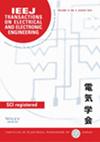下载PDF
{"title":"QRS Detection in Noisy Electrocardiogram Based on Multi-Parameter Constrained Stochastic Resonance","authors":"Wenyu Shang, Masaki Sekino","doi":"10.1002/tee.70062","DOIUrl":null,"url":null,"abstract":"<p>One major challenge of QRS wave detection is the deleterious impact of inevitable noise in electrocardiogram (ECG) signals, which can deteriorate the detection performance of algorithms. Previous research has shown a nonlinear monostable potential-based algorithm for enhancing the QRS complex in a noisy environment. Its main mechanism is the stochastic resonance effect, which transfers noise energy to information-carrying ECG signals in the nonlinear potential. However, the QRS detection algorithm based on monostable stochastic resonance (MSR) exhibits a limited noise margin to maintain extremely good performance. To further improve noise robustness, we propose a multi-parameter constrained bistable SR (MCBSR) module for the QRS detection algorithm without requiring a large amount of training data. The MCBSR module can maximize the ECG signal while suppressing noise when there is a QRS complex and minimizes the ECG signal otherwise. Using four publicly available databases for testing, the MCBSR-based QRS detection algorithm has been proven to achieve superior performance among state-of-the-art algorithms. Compared to the conventional nonlinear method, the MCBSR enables the QRS detection algorithm to have significantly stronger noise robustness under various noise types. Therefore, this study successfully provides a more excellent nonlinear potential and greatly enhances the noise robustness of the QRS detection algorithm in large noise environments. © 2025 The Author(s). <i>IEEJ Transactions on Electrical and Electronic Engineering</i> published by Institute of Electrical Engineers of Japan and Wiley Periodicals LLC.</p>","PeriodicalId":13435,"journal":{"name":"IEEJ Transactions on Electrical and Electronic Engineering","volume":"20 11","pages":"1745-1756"},"PeriodicalIF":1.1000,"publicationDate":"2025-05-21","publicationTypes":"Journal Article","fieldsOfStudy":null,"isOpenAccess":false,"openAccessPdf":"https://onlinelibrary.wiley.com/doi/epdf/10.1002/tee.70062","citationCount":"0","resultStr":null,"platform":"Semanticscholar","paperid":null,"PeriodicalName":"IEEJ Transactions on Electrical and Electronic Engineering","FirstCategoryId":"5","ListUrlMain":"https://onlinelibrary.wiley.com/doi/10.1002/tee.70062","RegionNum":4,"RegionCategory":"工程技术","ArticlePicture":[],"TitleCN":null,"AbstractTextCN":null,"PMCID":null,"EPubDate":"","PubModel":"","JCR":"Q4","JCRName":"ENGINEERING, ELECTRICAL & ELECTRONIC","Score":null,"Total":0}
引用次数: 0
引用
批量引用
Abstract
One major challenge of QRS wave detection is the deleterious impact of inevitable noise in electrocardiogram (ECG) signals, which can deteriorate the detection performance of algorithms. Previous research has shown a nonlinear monostable potential-based algorithm for enhancing the QRS complex in a noisy environment. Its main mechanism is the stochastic resonance effect, which transfers noise energy to information-carrying ECG signals in the nonlinear potential. However, the QRS detection algorithm based on monostable stochastic resonance (MSR) exhibits a limited noise margin to maintain extremely good performance. To further improve noise robustness, we propose a multi-parameter constrained bistable SR (MCBSR) module for the QRS detection algorithm without requiring a large amount of training data. The MCBSR module can maximize the ECG signal while suppressing noise when there is a QRS complex and minimizes the ECG signal otherwise. Using four publicly available databases for testing, the MCBSR-based QRS detection algorithm has been proven to achieve superior performance among state-of-the-art algorithms. Compared to the conventional nonlinear method, the MCBSR enables the QRS detection algorithm to have significantly stronger noise robustness under various noise types. Therefore, this study successfully provides a more excellent nonlinear potential and greatly enhances the noise robustness of the QRS detection algorithm in large noise environments. © 2025 The Author(s). IEEJ Transactions on Electrical and Electronic Engineering published by Institute of Electrical Engineers of Japan and Wiley Periodicals LLC.
基于多参数约束随机共振的噪声心电图QRS检测
QRS波检测的一个主要挑战是心电图信号中不可避免的噪声的有害影响,这会降低算法的检测性能。以前的研究已经提出了一种基于非线性单稳定电位的算法来增强噪声环境下的QRS复合体。其主要机制是随机共振效应,将噪声能量在非线性电位中传递给携带信息的心电信号。然而,基于单稳定随机共振(MSR)的QRS检测算法表现出有限的噪声余量以保持极好的性能。为了进一步提高噪声的鲁棒性,我们在不需要大量训练数据的情况下,为QRS检测算法提出了一种多参数约束双稳态SR (MCBSR)模块。当存在QRS复合体时,MCBSR模块可以使心电信号最大化,同时抑制噪声;反之,则使心电信号最小化。使用四个公开可用的数据库进行测试,基于mcbsr的QRS检测算法已被证明在最先进的算法中具有优越的性能。与传统的非线性方法相比,MCBSR使QRS检测算法在各种噪声类型下具有更强的噪声鲁棒性。因此,本研究成功地为QRS检测算法提供了更优异的非线性潜力,极大地增强了QRS检测算法在大噪声环境下的噪声鲁棒性。©2025作者。电气与电子工程学报,日本电气工程师学会和Wiley期刊公司出版。
本文章由计算机程序翻译,如有差异,请以英文原文为准。


 求助内容:
求助内容: 应助结果提醒方式:
应助结果提醒方式:


